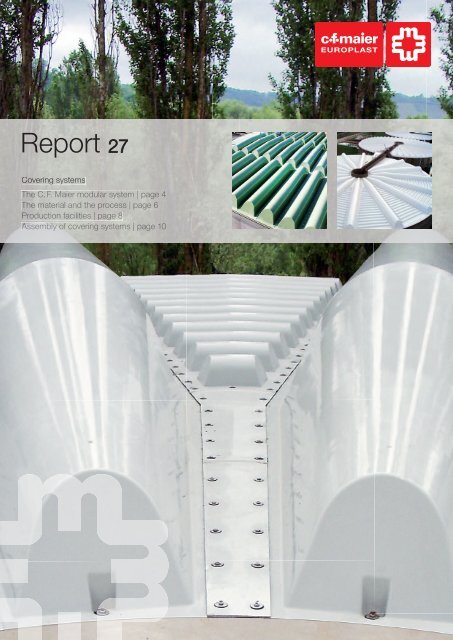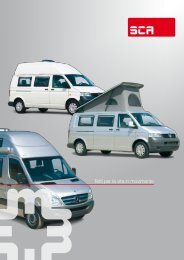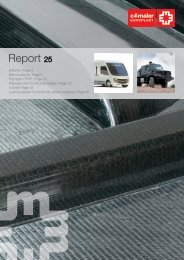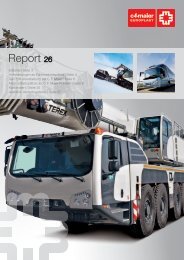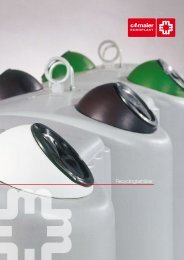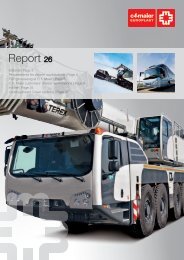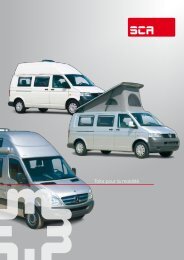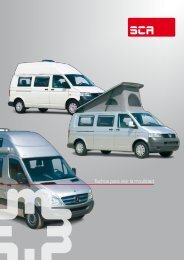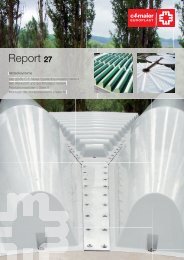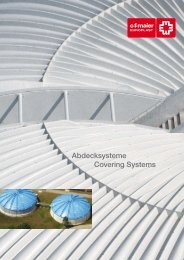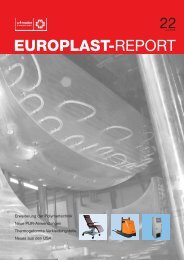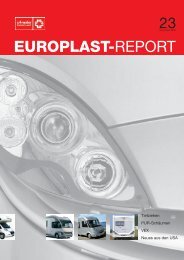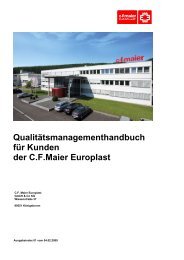You also want an ePaper? Increase the reach of your titles
YUMPU automatically turns print PDFs into web optimized ePapers that Google loves.
<strong>Report</strong> <strong>27</strong><br />
Covering systems<br />
The C. F. <strong>Maier</strong> modular system | page 4<br />
The material and the process | page 6<br />
Production facilities | page 8<br />
Assembly of covering systems | page 10
Contents<br />
Editorial<br />
<strong>Europlast</strong> <strong>Report</strong> <strong>27</strong><br />
Publisher<br />
The Management Board of the<br />
C. F. <strong>Maier</strong> group of companies<br />
Responsible for content<br />
Birgit Lüddecke<br />
Postfach 11 10<br />
89548 Königsbronn<br />
Phone +49 7328 81-171<br />
birgit.lueddecke@c-f-maier.de<br />
Design and technology<br />
wortundform GmbH, Munich<br />
www.wortundform.de<br />
Production<br />
Theilacker, Herbrechtingen-Bolheim<br />
www.theilacker.info<br />
Photo credits<br />
C. F. <strong>Maier</strong>: 1, 4 – 5, 7 right, 8 top left, 9 top right<br />
and bottom, 10 – 11, 12 bottom, 13 – 14, 15 top<br />
left and bottom, 16 – 19, 20 top and bottom left,<br />
21 – 24, 25 top left and bottom, 26<br />
Mercedes-Benz: <strong>27</strong><br />
wortundform: 3, 6, 7 left, 8 top right and bottom,<br />
9 top left, 20 bottom right<br />
Editorial 3<br />
Covering systems<br />
The C. F. <strong>Maier</strong> modular system 4<br />
The material and the process 6<br />
Production facilities 8<br />
Assembly of covering systems 10<br />
Examples of covering systems 12<br />
Specific solutions and details 17<br />
Color and shape 22<br />
The Middle East market 23<br />
Look ahead to EP <strong>Report</strong> 28: “SMC (Sheet Molding Compound)” <strong>27</strong><br />
Dear Readers,<br />
More than thirty years ago, C. F. <strong>Maier</strong> began to<br />
manufacture sewage treatment plant covers, and<br />
it started with a major project – the covering of<br />
the BASF factory’s sewage treatment plant of<br />
60,000 square meters in size. Since then, we<br />
have developed a complete modular system with<br />
designs for every conceivable covering job, plus<br />
the tools to match. That made us the market<br />
leader in Germany and its neighboring countries.<br />
Projects not connected to sewage treatment –<br />
for example relating to water reservoirs or building<br />
construction – were also handled, but remained<br />
the exception.<br />
There were always competitors who tried to chip<br />
away at our market shares by low prices. Later on,<br />
we were often asked to repair or replace those<br />
“cheap” covers. These days, however, clients have<br />
realized that we offer unbeatable advantages,<br />
thanks to interesting and economical designs,<br />
reliable structural analyses, inexpensive production<br />
precisely matching the specification, and invaluable<br />
assistance during assembly.<br />
Project planning, design, structural analysis and<br />
coordination of order processing are at home in<br />
Königsbronn, while production of glass fiber reinforced<br />
polyester resin elements is concentrated<br />
at ITAP, C. F. <strong>Maier</strong>’s company in Tunisia. For the<br />
important Gulf market, the C. F. <strong>Maier</strong> Shairco<br />
KSA joint venture was created in Saudi Arabia as<br />
a further production location.<br />
In this report we will be familiarizing you with<br />
more recent and technically interesting applications<br />
and also with current design trends for our<br />
covering systems, and we hope you will benefit<br />
from them for your field of activity.<br />
Dipl.-Ing. (FH) Gerhard Lettl,<br />
Managing Director, C. F. <strong>Maier</strong> <strong>Europlast</strong><br />
2 Editorial 3
A solution<br />
for everything<br />
Type L, spiral pump station in Cottbus<br />
Type C, polygonal tower cover in Warstein<br />
The C. F. <strong>Maier</strong> modular system<br />
It would be going too far to list and illustrate here<br />
every model of our covering systems that we<br />
designed and delivered. There’s a separate brochure<br />
with a systematic description of our engineering<br />
concepts (“Covering Systems – Technical<br />
Concept”), which we would be happy to send<br />
you on request. Just this much: we’d like to demonstrate<br />
clearly the sheer range of what we can<br />
do with a few pictures – and they’re mainly of<br />
more recent projects: for circular tanks of almost<br />
any span, with and without central support or<br />
walkway, for rectangular tanks, channels, spiral<br />
pump stations, special designs and so on and<br />
so forth …<br />
Type AB, channel in Augsburg<br />
Type Af, rectangular tank in Bratislava<br />
Type G5, circular tanks with 37 m<br />
diameter in Crossness / London<br />
Type E2, dome in Hückelhoven, 20 m<br />
diameter<br />
Type Af, rectangular tank in Colbitz<br />
Type D1, circular tanks in Wiehl<br />
4 Covering systems 5
Sturdy and<br />
economical<br />
Competent and<br />
experienced<br />
GRP as a material<br />
How we approach a project<br />
Our covering systems are made almost exclusively<br />
from glass-fi ber reinforced plastic resins (GRP).<br />
These materials and their advantages have been<br />
well known for many years: high strength, low<br />
weight, chemical resistance, good colorability<br />
and UV resistance, maximum options for shaping.<br />
Extreme resistance to weathering and ageing –<br />
covers we supplied more than thirty years ago<br />
are still in use today.<br />
We incorporate the glass fi ber component in the<br />
form of mats, fabrics and non-wovens, with strict<br />
adherence to the structural analysis and with<br />
appropriate safety margins. Stainless steel is used<br />
for connecting elements. Cut edges, drilled holes<br />
and the like are carefully sealed for dependable prevention<br />
of moisture penetration into the laminate.<br />
When we receive an inquiry, we are able, thanks<br />
to many years of experience and a wealth of<br />
available designs, to provide in a very short time<br />
a fully valid quotation for the most economical<br />
solution in the specifi c case. We don’t need to<br />
make compromises, because we can draw on<br />
our extensive engineering skills.<br />
For major projects, we visit to get a personal<br />
impression of the local situation. We can also as<br />
a rule cater to special requirements in the visual<br />
or engineering respect thanks to our extensive<br />
capabilities.<br />
Structural analyses are already available for all<br />
the variants of our modular system, so only the<br />
dimensions relating to the specifi c case and perhaps<br />
specifi c loads, such as high wind or snow<br />
loads, have to be inserted. That makes our quotations<br />
dependable and binding from the very<br />
start – the client doesn’t have to fear subsequent<br />
demands.<br />
We use 2-D and 3-D CAD systems for our design<br />
work. The latter are useful for more complex designs,<br />
when the client has to be provided with a<br />
clearer idea of the solution found by means of<br />
computer animations.<br />
Structural analysis using the FEM<br />
method<br />
3-D animation of a circular tank with<br />
walkway<br />
Glass fiber fabric on a CNC cutting<br />
system<br />
CAD design<br />
Strength testing in our own laboratory<br />
as part of our quality monitoring<br />
3-D animation of two circular tanks<br />
6 Covering systems 7
European<br />
standards<br />
Our production capabilities<br />
Laminating of flat elements at ITAP<br />
Laminating of flat elements at ITAP<br />
C. F. <strong>Maier</strong>’s Tunisian plant ITAP, with some 300<br />
employees, has enough capacity to cope with<br />
major projects too. This up-to-date company is<br />
under German management and is certifi ed to<br />
European standards.<br />
The new C. F. <strong>Maier</strong> Shairco KSA joint venture in<br />
the Kingdom of Saudi Arabia is also headed by<br />
a German plant manager.<br />
C. F. <strong>Maier</strong> Shairco KSA in Saudi Arabia<br />
Partial view of the C. F. <strong>Maier</strong> plant ITAP in Tunisia<br />
Production of covering elements at ITAP<br />
Markings for supporting ribs / metal<br />
inserts<br />
Material warehouse at C. F. <strong>Maier</strong><br />
Shairco KSA<br />
Part production at C. F. <strong>Maier</strong> Shairco KSA<br />
8 Covering systems 9
Assembly<br />
without problems<br />
Installation made easy<br />
Positioning a preassembled dome<br />
using a mobile crane<br />
Until a few years ago, we maintained our own<br />
assembly teams. Sending them off to distant assembly<br />
locations inevitably made the projects<br />
more expensive. We have now long since gone<br />
over to commissioning a contractor and our partners<br />
on the spot with the assembly work. We make<br />
their work easier by<br />
– supplying precisely dimensioned and ready-made<br />
parts that only need to be bolted together;<br />
– including self-explanatory plans;<br />
– writing an assembly manual for every project and,<br />
if necessary,<br />
– adding instructions for building auxiliary equipment.<br />
– offering an assembly supervisor from our own<br />
factory, although our excellent prior information<br />
often means he is not called upon.<br />
– being present at the fi nal inspection if this is required.<br />
–<br />
–<br />
–<br />
The following pictures show the most important<br />
assembly aids that we specify or even make ourselves,<br />
such as<br />
mobile cranes<br />
gantry cranes for emplacement (according to our<br />
drawings and adapted to the respective project)<br />
assembly towers (according to our drawings,<br />
custom-built for the application)<br />
Our experience in many international projects<br />
proves that there are no assembly problems, anywhere<br />
in the world, when our method is used.<br />
Assembly tower inside tank<br />
Movable gantry crane<br />
Inserting the secondary support elements<br />
following assembly of the main<br />
support members in type G5<br />
10 Covering systems 11
Lattice beams make<br />
things possible<br />
Large spans crossed at low expense<br />
Aerial view of Stuttgart-Mühlhausen plant<br />
(© 2012 Google, image © 2008 GeoBasis-DE / BKG)<br />
Computer animation of 4 tanks of the<br />
Jeddah North plant (KSA)<br />
In very large circular tanks – of about 40 meters<br />
diameter and up – and also in particularly wide<br />
rectangular tanks, self-supporting GRP elements<br />
come up against their limits – not because the<br />
material is limited, but because of the excessive<br />
length of the individual parts and the problems<br />
this causes for shaping, handling, transport and<br />
costs.<br />
For cases like this, we have had solutions to<br />
hand for ten years now, in which parallel steel<br />
lattice beams span the tanks with a spacing of<br />
about 8 meters. The plastic elements are suspended<br />
from these beams.<br />
Infraserv, Wiesbaden, chord span 25 m,<br />
element span up to 8 m<br />
Stuttgart-Mühlhausen, 3 tanks, area 3 ×<br />
<strong>27</strong>00 sq. m, chord span up to 60 m,<br />
element span up to 8.4 m<br />
Jeddah North, KSA, 8 tanks, area 8 ×<br />
2500 sq. m, chord span up to 56 m,<br />
element span up to 7.8 m<br />
12 Covering systems 13
Domes –<br />
yes and no<br />
Covers for 18 – 40 meter tank diameters<br />
As a rule, we use dome covers with profiled elements<br />
in the case of circular tanks of up to 40<br />
meters diameter – three examples are shown below<br />
and right. But for this size range too it may<br />
be that a dome isn’t the optimum solution, such<br />
as when<br />
The principle of combining a load-bearing steel<br />
superstructure with suspended GRP elements<br />
has proved to be so economical that in recent<br />
years we have applied it even to smaller tanks –<br />
down to only 18 meters diameter – usually in<br />
combination with barrel shells and flat elements.<br />
Alicante (Spain), 2 tanks with 32 m diameter<br />
(© 2012 Google, image © 2007 GeoEye)<br />
– there is no preassembly space next to the tank;<br />
– built-in parts like hatches are specified, which are<br />
hard to access on a curving dome surface;<br />
– no auxiliary frame can be placed inside the tank<br />
because the latter can’t be taken out of service;<br />
– the air volume underneath the cover has to be<br />
kept small on account of the waste air treatment.<br />
In cases like this, steel beam superstructures are<br />
a low-cost alternative. Preassembly requires only<br />
a narrow strip next to the tank. After assembly of<br />
the steel beam superstructure, the plastic elements<br />
can be fitted using a crane and without an internal<br />
frame. The steel structure stays outside the corrosive<br />
atmosphere, so expensive stainless steel<br />
is not necessary. The steel superstructure can also<br />
be used as an access walkway, and if required<br />
can support additional loads, for example from<br />
mounting of an agitator.<br />
Schönwohld, 13 m diameter<br />
Lich, <strong>27</strong> m diameter<br />
Mergelstetten, 2 tanks of 33 m diameter<br />
Greding, 19 m diameter<br />
Lucerne (Switzerland), 18 m diameter<br />
Heilsbrunn, 20 m diameter<br />
14 Covering systems 15
Barrel shells:<br />
high load capacity<br />
Flexible<br />
sealing<br />
Still<br />
like new<br />
Inexpensive solution for small tanks<br />
For circular and rectangular tanks with spans<br />
between 8 and 17 meters too, there may be local<br />
circumstances which rule out a dome solution:<br />
lack of space for preassembly, shutdown of the<br />
tank not possible, hatches at awkward points,<br />
requirement for partial dismantling for inspection<br />
purposes, requirement for lowest possible air<br />
space above the sewage.<br />
In this diameter range, no load-bearing steel<br />
structure is needed, and instead GRP barrel<br />
shells are used as self-supporting beams (main<br />
support elements), with walk-on flat elements (for<br />
secondary support) between them – an unusually<br />
inexpensive and variable solution. Usually the<br />
barrel shells are slightly angled in the center to<br />
improve rainwater drain-off. We used to design<br />
the main support elements as sandwich beams<br />
with a hard foam core; today’s barrel shells are<br />
considerably more advantageous.<br />
The idea: plastic lips<br />
The task: in the sand-trap tank, solids on the<br />
tank floor must be scraped or drawn off in the<br />
longitudinal direction. To do so, the tanks have<br />
an electrically driven scraper bridge from which<br />
the scraper devices pass down to the tank bottom.<br />
The problem: the tank has to remain sealed and<br />
odor-tight.<br />
The solution: Obliquely arranged plastic lips are<br />
integrated into the flat elements of the GRP cover,<br />
and are sealed until the moment that the link rods<br />
of a scraping tool on the bridge pass through.<br />
Then they close again.<br />
This solution has now proved its worth in many<br />
instances. It does require plenty of knowhow, not<br />
least in respect of the material used for the lips.<br />
24 years on: GRP water tower roof<br />
The following example shows that GRP covers<br />
aren’t limited to sewage treatment plants: more<br />
than twenty years ago, the dilapidated roof of a<br />
water tower in Essen, a protected monument,<br />
had to be replaced by a modern structure, but<br />
with the new roof outwardly matching the old<br />
one in every detail in respect of its shape and<br />
color. Our solution was a sandwich / segment<br />
structure with 40 supporting ribs on its underside<br />
and an 80 mm thick thermal insulation layer of<br />
polyurethane foam. Due to the extremely out-ofround<br />
nature of the tower, every segment together<br />
with its ribs had to be made individually. A tensided<br />
lantern mounting and an all-round fascia<br />
had to be made to match the original.<br />
The dome of 19.5 meter diameter and weighing<br />
13.5 tons was completely assembled next to the<br />
water tower and then precisely positioned using<br />
a truck crane.<br />
Compared with dome solutions, which can be<br />
quite handsome as shown in the examples on<br />
pages 14 and 15, structures with barrel shells are<br />
as a rule less expensive and so are frequently<br />
preferred even when a dome solution would be<br />
just as feasible from the engineering viewpoint.<br />
Plattling, 13.6 m diameter<br />
The building and the cast-iron inner tank are now<br />
due for another general renovation – but its GRP<br />
roof isn’t. It has lasted 24 years unscathed!<br />
Perl Besch, 17.8 m diameter<br />
Warstein, 15 m diameter<br />
Easily discerned: the lips open only<br />
where the link rods pass through<br />
Mounting of the preassembled dome<br />
in Essen<br />
16 Covering systems 17
Air sealing<br />
problem<br />
Large<br />
flap<br />
Hazardous<br />
gases<br />
Better than<br />
stainless steel<br />
Covers with special seal<br />
In denitrification tanks, no oxygen can be allowed<br />
to get into the vessel’s interior – the cover has to<br />
be absolutely airtight. We have met that requirement<br />
with our system F2. The so-called main<br />
support members rest on the tank rim; lightly<br />
profiled secondary support elements are provided<br />
in the spandrels between them. All connecting<br />
lines are sealed with special soft plastic sections.<br />
The image shows at the back a tank with 22.5<br />
meters diameter.<br />
The same basic design was also selected for the<br />
sake of visual uniformity for the biological filter in<br />
the foreground, where however airtightness is<br />
not crucial – quite the contrary: this is an open<br />
tank; the cover only has the job of protecting the<br />
fine nozzles of a rotary sprinkler from freezing up<br />
in winter. This is assured by the circular cover<br />
along the tank rim, which is the area particularly<br />
at risk.<br />
Bunker covering with electric drive<br />
A large-sized cover (4.5 × 2.5 meters) that had<br />
to be able to open completely was needed for<br />
several sludge bunkers. The solution: a swing-up<br />
and air-tight flap with cable hoist and electric<br />
winch. It was designed and built completely by<br />
C. F. <strong>Maier</strong>.<br />
Explosion prevention for sedimentation<br />
tanks<br />
Inflammable gas mixes can form in sewage tanks.<br />
GRP as a material is not in principle electrically<br />
conductive, so explosions might result in the<br />
event of electrostatic charging. To prevent that,<br />
graphite or soot used to be admixed with the<br />
synthetic resin. Today, we achieve good conductivity<br />
with a special resin sealant on the inner<br />
surface of the covers. To do so, the elements are<br />
also connected to a grounding system.<br />
The cover shown in the picture was inspected<br />
and approved by TÜV.<br />
Fe(III) precipitation in a drainage<br />
channel<br />
There are special cases in sewage treatment<br />
where even expensive stainless steel fails and<br />
GRP is the best choice, for example in Fe(III)<br />
precipitation. Stainless steel corrodes under continuous<br />
contact with the medium. For this case,<br />
C. F. <strong>Maier</strong> has built a GRP drainage channel<br />
together with drainage shaft. The weight of the<br />
sewage flowing through called for a strong supporting<br />
structure that could be made of stainless<br />
steel, as it does not come into direct contact<br />
with the medium.<br />
Nessingen<br />
Munich – Gut Großlappen<br />
Grounding elements<br />
Channel with drainage shaft<br />
18 Covering systems 19
Protection of<br />
drinking water<br />
Minor but<br />
necessary<br />
Covers for waterworks<br />
To prevent both water contamination and high<br />
humidity above the open water surfaces inside<br />
the building, the fi lter cells in waterworks need to<br />
be covered up. The materials used must have a<br />
KTW approval or at least a drinking water mendation.<br />
We have already designed several covers of this<br />
type. The images show two examples. Easy removability<br />
of the elements is always required,<br />
and furthermore a visually attractive and tidy<br />
appearance is recomappreciated.<br />
Special requirements<br />
Sloping surfaces and stairway accesses, exits<br />
and boxes, walls and superstructures – all that<br />
might have to be built or covered as part of a<br />
major project. With our range of molds that has<br />
grown over the years, we can cater to almost all<br />
these special requirements practically straight<br />
away. The images show three examples: An enclosed<br />
stairway into the tank interior, a cover with<br />
sloping connection to a building, and a 3.5 meter<br />
high GRP annular wall as impact apron – considerably<br />
less expensive than the otherwise usual<br />
stainless steel structures.<br />
GRP annular wall<br />
Colbitz Computer animations for Oeversee<br />
Stairway access into tank interior Sloping connection to building; flat<br />
part with inspection flaps and carrier<br />
shells<br />
20 Covering systems 21
Architectonically<br />
ambitious<br />
Trust is<br />
crucial<br />
Elements for Raysut (Oman)<br />
Color and shape<br />
Sewage treatment plants don’t have to be just<br />
dull and functional. Modern architects often use<br />
powerful colors, with simple and clear forms<br />
dominating the structures. The covers of the<br />
sedimentation tanks have to match the architecture<br />
in their shape and color – a wish we’re happy<br />
to grant. In the first picture, the cover for the spiral<br />
pump stations had to be matched to the color<br />
and shape of the colorful trapezoidal sheet metal<br />
facades. We used the pale gray color found in<br />
the adjacent walls and designed the reinforcing<br />
ribs of the cover elements in trapezoidal form.<br />
In this way the plastic structure is ideally integrated<br />
into the whole.<br />
Successful in the Gulf region<br />
In Arab countries, trust is perhaps an even more<br />
important factor than elsewhere in the world.<br />
So a lot of preparatory work was needed before<br />
the first order was placed with C. F. <strong>Maier</strong> in 2005.<br />
It came from Bahrain. Numerous other projects<br />
followed in Dubai, Abu Dhabi, Saudi Arabia and<br />
Oman. The economic benefits of our designs,<br />
the quality of workmanship and the dependable<br />
compliance with agreed deadlines have become<br />
our most important references, while our joint<br />
venture in Saudi Arabia helps us to ensure the<br />
mandatory local content.<br />
In the next picture, a GRP trapezoidal sheet metal<br />
wall with the same color was placed on the steel<br />
tank underneath it. The roof is a barrel shell with<br />
flat elements in the same dark blue as the adjoining<br />
building.<br />
Göttingen<br />
Göttingen<br />
Lanxess, La Wantzenau (France)<br />
Al Quaa (United Arab Emirates)<br />
Yas Island (Abu Dhabi)<br />
22 Covering systems 23
A major system<br />
in the making<br />
The Jeddah North Project (KSA)<br />
Computer animation of 4 of the 8 secondary<br />
sedimentation tanks, 56.5 m<br />
diameter<br />
Satellite image at the start of assembly<br />
(© 2012 Google, image © 2010 GeoEye)<br />
Jeddah Airport in the Kingdom of Saudi Arabia<br />
is becoming more and more important not least<br />
due to the enormous and steadily increasing<br />
number of pilgrims to Mecca arriving and departing<br />
by plane. At the same time, the requirements<br />
placed on the infrastructure in the airport<br />
region are growing, which is why a large-scale<br />
sewage treatment plant near the airport is<br />
needed.<br />
It was clear right from the start that the sedimentation<br />
tanks had to be covered: open water<br />
surfaces attract birds which can endanger air<br />
traffic, and above all the sight of an open sewage<br />
treatment plant was not desirable as the<br />
first impression that incoming passengers<br />
should receive.<br />
A total of some 60,000 square meters had to be<br />
covered, spread over many tanks with different<br />
shapes and functions. When the order was placed,<br />
the preliminary building work on the tanks was<br />
already far advanced, so the existing structures<br />
had to be taken into account during planning<br />
work on the covers. A further requirement was<br />
to keep the air volume underneath the covers of<br />
tanks where waste air had to be treated as small<br />
as possible. Finally, the construction concept<br />
had to be economically viable and feasible with<br />
existing designs and with our range of molds.<br />
The overall layout (picture right) shows the solution<br />
arrived at and accepted by the client. For the<br />
eight large circular tanks with over 50 meters<br />
diameter, steel lattice beams cross the structure,<br />
and underneath GRP wave elements are suspended.<br />
The result was a quite filigree structure<br />
which was preferred over the originally considered<br />
dome solution.<br />
The large rectangular areas are all covered with<br />
barrel shells as the main beams with plate elements<br />
between them. This results in a visual<br />
breaking up of the enormous areas. For the<br />
semi-round closures and also for the circular<br />
tanks on the right, we have again achieved a<br />
uniform appearance with centrally arranged<br />
barrel shells.<br />
The contractually specified production and delivery<br />
deadline of one year was kept.<br />
Further images show partial sections of the plant<br />
during assembly.<br />
General view of plant<br />
All images of this row: covers for 8<br />
aeration tanks (155 x 30 m) during<br />
assembly<br />
24 Covering systems 25
Impressive<br />
dimensions<br />
Looking ahead:<br />
<strong>Europlast</strong> <strong>Report</strong> 28<br />
Lagoon Covers – visionary project in<br />
the tender stage<br />
The situation: In a coastal region of the Kingdom<br />
of Saudi Arabia, a collecting tank is to be built for<br />
treated sewage that has to be piped up to 150<br />
kilometers into the interior for irrigating agricultural<br />
crop areas.<br />
The task: A total of 100,000 square meters of<br />
tank area should be covered without the use of<br />
supports. The span is more than 150 meters.<br />
Our three approaches each with several variations:<br />
in any event a steel superstructure with<br />
suspended GRP elements which then have<br />
spans of up to 13 meters.<br />
As the computer animations show, the steel<br />
superstructure comprises optionally<br />
SMC – material for medium-sized and<br />
large runs<br />
The next <strong>Report</strong> will be about SMC (Sheet Molding<br />
Compound) – a classic GRP material that’s<br />
playing an increasing role at C. F. <strong>Maier</strong>.<br />
Our debut in SMC processing took place in a<br />
niche, i.e. with low-pressure SMC used only by a<br />
few GRP companies. It manages with lower specific<br />
pressures than classic SMC and with aluminum<br />
instead of steel tools, making it economical<br />
also for small annual requirements as are usual<br />
in bus, coach and truck production. Low-pressure<br />
SMC remains an important field for C. F. <strong>Maier</strong> –<br />
in addition to the classic SMC which is growing<br />
in importance. We will be reporting on our extensive<br />
experience with this material and on its potential<br />
in <strong>Report</strong> 28.<br />
– an arched structure,<br />
– lattice beams with cable bracing or<br />
– 150 meter long conventional lattice beams.<br />
In cooperation with a steel construction company,<br />
the drafts were thoroughly planned up to the assembly<br />
manual stage and are technically feasible.<br />
26 Covering systems Look ahead<br />
<strong>27</strong>
C. F. <strong>Maier</strong><br />
GmbH & Co KG<br />
Postfach 11 10<br />
89548 Königsbronn<br />
Wiesenstraße 24<br />
89551 Königsbronn<br />
Phone +49 7328 81-01<br />
Fax +49 7328 81-104<br />
cfm-info@c-f-maier.de<br />
www.c-f-maier.de<br />
C. F. <strong>Maier</strong> <strong>Europlast</strong><br />
GmbH & Co KG<br />
Postfach 11 60<br />
89548 Königsbronn<br />
Wiesenstraße 43<br />
89551 Königsbronn<br />
Phone +49 7328 81-07<br />
Fax +49 7328 81-286<br />
ep-info@c-f-maier.de<br />
www.c-f-maier.de<br />
C. F. <strong>Maier</strong> Kunstharzwerk<br />
GmbH & Co KG<br />
Postfach 11 60<br />
89548 Königsbronn<br />
Wiesenstraße 37–43<br />
89551 Königsbronn<br />
Phone +49 7328 81-02<br />
Fax +49 7328 81-218<br />
khw-info@c-f-maier.de<br />
www.c-f-maier.de<br />
C. F. <strong>Maier</strong> Leichtgusswerk<br />
GmbH & Co KG<br />
Postfach 11 65<br />
89548 Königsbronn<br />
Wiesenstraße 43–47<br />
89551 Königsbronn<br />
Phone +49 7328 81-05<br />
Fax +49 7328 81-196<br />
lgw-info@c-f-maier.de<br />
www.c-f-maier.de<br />
C. F. <strong>Maier</strong> Polymertechnik<br />
GmbH & Co KG<br />
Postfach 11 41<br />
91581 Schillingsfürst<br />
Industriestraße 10<br />
91583 Schillingsfürst<br />
Phone +49 9868 75-0<br />
Fax +49 9868 75-99<br />
pts-info@c-f-maier.de<br />
www.c-f-maier.de<br />
C. F. <strong>Maier</strong> Polimer Teknik<br />
Ltd. Şti.<br />
E-5 Karayolu üzeri<br />
Marmaracık Mevkii<br />
59850 Çorlu / Tekirdağ<br />
Turkey<br />
Phone +90 282 68467-00<br />
Fax +90 282 68467-01<br />
info-ptt@c-f-maier.com.tr<br />
www.c-f-maier.de<br />
C. F. <strong>Maier</strong> Polimer-Technikai<br />
Kft.<br />
Felszabadulás útja 112<br />
2645 Nagyoroszi<br />
Hungary<br />
Phone +36 35 574571<br />
Fax +36 35 375066<br />
ptu-info@c-f-maier.de<br />
www.c-f-maier.de<br />
ITAP – Industrie Tuniso-<br />
Allemande du Plastique<br />
S.A.R.L.<br />
Zone Industrielle El Mazraâ<br />
8024 Tazarka<br />
Tunisia<br />
Phone +216 72 225<strong>27</strong>8<br />
Fax +216 72 225435<br />
itap-info@c-f-maier.de<br />
www.c-f-maier.de<br />
C. F. <strong>Maier</strong> Composites Inc.<br />
500 East Crystal Street<br />
Lamar, Colorado 81052<br />
USA<br />
Phone +1 719 3368745<br />
Fax +1 719 3363091<br />
mail@cfmaier.com<br />
www.cfmaier.com<br />
C. F. <strong>Maier</strong> Composites Inc.<br />
Coors Technology Center<br />
16351 Table Mountain Pkwy.<br />
Golden, Colorado 80403-1641<br />
USA<br />
Phone +1 303 <strong>27</strong>88013<br />
Fax +1 303 <strong>27</strong>80940<br />
golden@cfmaier.com<br />
www.cfmaier.com<br />
C. F. <strong>Maier</strong> Shairco KSA Ltd.<br />
P.O. Box 9301<br />
Jeddah 21413<br />
Saudi Arabia<br />
Phone +966 2 2682840<br />
Fax +966 2 2682430<br />
cfm-info@c-f-maier.de<br />
www.c-f-maier.de


